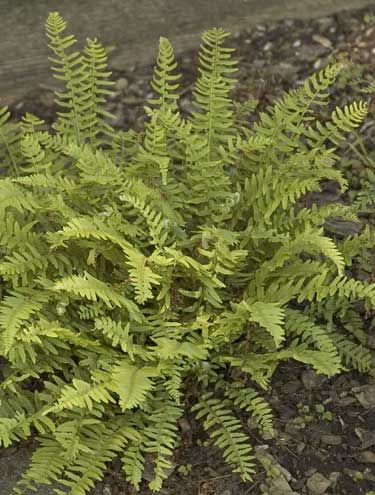|
Hardy Fern Home W. polystichoides resources
All Ferns � Woodsiaceae �� Woodsia
�Other Genera
|
| Woodsia polystichoides | ||
Holly fern woodsia | ||
|
Etymology
Polystichoides means looking like the fern Polysticum.
Description
Rhizome: erect, short, scaly.
Frond: 30 cm high by 5 cm wide, deciduous, monomorphic, blade/stipe ratio: 3:1. Stipe: red-brown, obliquely jointed at top, old stipe bases 4-7 cm., densely scaly at base, sparsely hairy and scaly above; scales lanceolate, to 6 x 2 mm, pale brown, vascular bundles: 2, round or oblong. Blade: 1-pinnate, narrowly lanceolate or linear, somewhat narrower at the base, herbaceous, soft, hairy on both surfaces, also scaly beneath, scales linear. Pinnae: 15 to 24 pair, pinnae lanceolate or oblong-lanceolate, eared upwards at the base, 25 x 7 mm; costae grooved above, grooves continuous from rachis to costae; margins entire or dentate ; veins free, simple or forked, ending before the margin. Sori: round, in one row near the margin, indusium: cup-like dissected into shallow lobes, hairy, basal, surrounding, sporangia: brownish. Culture
Habitat: on rocks in sun.
Distribution: eastern Asia.
Hardy to -30�C, USDA Zone 4.
Distinctive Characteristics
This and W. intermedia are similar, but this is a larger plant with many more pinnae pairs. Also, the upper pinnae in W. intermedia are adnate to the rachis, not so here. Both species are distinguished in having the stipes jointed at the top.
|
|
|
Notes
Compare to This and W. intermedia are 1-pinnate. All other Woodsia are more divided. – Tom
Compare to This and W. intermedia are 1-pinnate. All other Woodsia are more divided. – Tom

Woodsia polystichoides. Early summer. Even under a hand lens (or via the click-through blow-up)�the indusium is indistinct, obscured by the many scales. �Scan: Tom Stuart |
